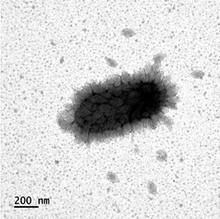| Nitrososphaerota | |
|---|---|

| |
| Nitrosopumilus maritimus, partially with virions of Nitrosopumilus spindle-shaped virus 1 (Thaspiviridae) attached. | |
| Scientific classification | |
| Domain: | |
| Superphylum: | |
| Phylum: | Nitrososphaerota Brochier-Armanet et al. 2021[1]
|
| Class: | |
| Order | |
| Synonyms | |
| |
The Nitrososphaerota (syn. Thaumarchaeota) are a phylum of the Archaea proposed in 2008 after the genome of Cenarchaeum symbiosum was sequenced and found to differ significantly from other members of the hyperthermophilic phylum Thermoproteota (formerly Crenarchaeota).[3][2][4] Three described species in addition to C. symbiosum are Nitrosopumilus maritimus, Nitrososphaera viennensis, and Nitrososphaera gargensis.[2] The phylum was proposed in 2008 based on phylogenetic data, such as the sequences of these organisms' ribosomal RNA genes, and the presence of a form of type I topoisomerase that was previously thought to be unique to the eukaryotes.[2][5] This assignment was confirmed by further analysis published in 2010 that examined the genomes of the ammonia-oxidizing archaea Nitrosopumilus maritimus and Nitrososphaera gargensis, concluding that these species form a distinct lineage that includes Cenarchaeum symbiosum.[6] The lipid crenarchaeol has been found only in Nitrososphaerota, making it a potential biomarker for the phylum.[7][8] Most organisms of this lineage thus far identified are chemolithoautotrophic ammonia-oxidizers and may play important roles in biogeochemical cycles, such as the nitrogen cycle and the carbon cycle. Metagenomic sequencing indicates that they constitute ~1% of the sea surface metagenome across many sites.[9]
Nitrososphaerota-derived membrane-spanning tetraether lipids (glycerol dialkyl glycerol tetraethers; GDGTs) from marine sediments can be used to reconstruct past temperatures via the TEX86 paleotemperature proxy, as these lipids vary in structure according to temperature.[10] Because most Nitrososphaerota seem to be autotrophs that fix CO2, their GDGTs can act as a record for past Carbon-13 ratios in the dissolved inorganic carbon pool, and thus have the potential to be used for reconstructions of the carbon cycle in the past.[7]
- ^ Oren A, Garrity GM (2021). "Valid publication of the names of forty-two phyla of prokaryotes". Int J Syst Evol Microbiol. 71 (10): 5056. doi:10.1099/ijsem.0.005056. PMID 34694987.
- ^ a b c d Brochier-Armanet C, Boussau B, Gribaldo S, Forterre P (March 2008). "Mesophilic Crenarchaeota: Proposal for a third archaeal phylum, the Thaumarchaeota". Nature Reviews Microbiology. 6 (3): 245–52. doi:10.1038/nrmicro1852. PMID 18274537. S2CID 8030169.
- ^ Tourna M, Stieglmeier M, Spang A, Könneke M, Schintlmeister A, Urich T, Engel M, Schloter M, Wagner M, Richter A, Schleper C (May 2011). "Nitrososphaera viennensis, an ammonia oxidizing archaeon from soil". Proceedings of the National Academy of Sciences of the United States of America. 108 (20): 8420–5. Bibcode:2011PNAS..108.8420T. doi:10.1073/pnas.1013488108. PMC 3100973. PMID 21525411.
- ^ DeLong EF (1992-06-15). "Archaea in coastal marine environments". Proceedings of the National Academy of Sciences. 89 (12): 5685–5689. Bibcode:1992PNAS...89.5685D. doi:10.1073/pnas.89.12.5685. ISSN 0027-8424. PMC 49357. PMID 1608980.
- ^ Brochier-Armanet C, Gribaldo S, Forterre P (December 2008). "A DNA topoisomerase IB in Thaumarchaeota testifies for the presence of this enzyme in the last common ancestor of Archaea and Eucarya". Biology Direct. 3: 54. doi:10.1186/1745-6150-3-54. PMC 2621148. PMID 19105819.
- ^ Spang A, Hatzenpichler R, Brochier-Armanet C, Rattei T, Tischler P, Spieck E, Streit W, Stahl DA, Wagner M, Schleper C (August 2010). "Distinct gene set in two different lineages of ammonia-oxidizing archaea supports the phylum Thaumarchaeota". Trends in Microbiology. 18 (8): 331–40. doi:10.1016/j.tim.2010.06.003. PMID 20598889.
- ^ a b Pearson A, Hurley SJ, Walter SR, Kusch S, Lichtin S, Zhang YG (2016). "Stable carbon isotope ratios of intact GDGTs indicate heterogeneous sources to marine sediments". Geochimica et Cosmochimica Acta. 181: 18–35. Bibcode:2016GeCoA.181...18P. doi:10.1016/j.gca.2016.02.034.
- ^ Pester M, Schleper C, Wagner M (June 2011). "The Thaumarchaeota: an emerging view of their phylogeny and ecophysiology". Current Opinion in Microbiology. 14 (3): 300–6. doi:10.1016/j.mib.2011.04.007. PMC 3126993. PMID 21546306.
- ^ Walker CB, de la Torre JR, Klotz MG, Urakawa H, Pinel N, Arp DJ, Brochier-Armanet C, Chain PS, Chan PP, Gollabgir A, Hemp J, Hügler M, Karr EA, Könneke M, Shin M, Lawton TJ, Lowe T, Martens-Habbena W, Sayavedra-Soto LA, Lang D, Sievert SM, Rosenzweig AC, Manning G, Stahl DA (May 2010). "Nitrosopumilus maritimus genome reveals unique mechanisms for nitrification and autotrophy in globally distributed marine crenarchaea". Proceedings of the National Academy of Sciences of the United States of America. 107 (19): 8818–23. Bibcode:2010PNAS..107.8818W. doi:10.1073/pnas.0913533107. PMC 2889351. PMID 20421470.
- ^ Schouten S, Hopmans EC, Schefuß E, Damste JS (2002). "Distributional variations in marine crenarchaeotal membrane lipids: a new tool for reconstructing ancient sea water temperatures?". Earth and Planetary Science Letters. 204 (1–2): 265–274. Bibcode:2002E&PSL.204..265S. doi:10.1016/S0012-821X(02)00979-2. S2CID 54198843.